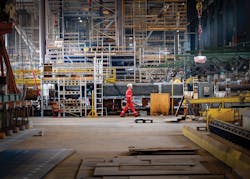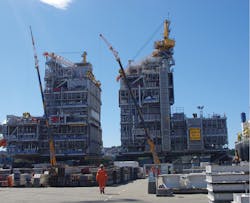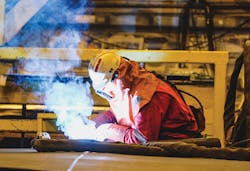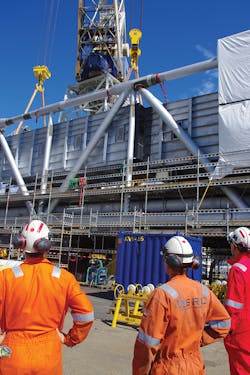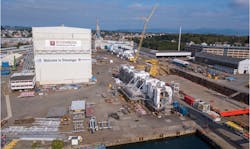Since 2013, the former Rosenberg fabrication yard in Stavanger has been part of the WorleyParsons group. The site, unlike most others in Europe, has had continuous activity since its formation around 125 years ago, when its focus was shipbuilding. Following the early discoveries of oil and gas offshore Norway in the 1960s and 1970s, it became part of Kvaerner and was for a time the country’s largest offshore construction yard. But when the oil price downturn struck in the 1990s, the newly merged Aker Kvaerner suddenly had too much yard capacity, and Rosenberg was sold to the Bergen Group.
Today it remains the sole large fabrication complex in the Stavanger area and under WorleyParsons’ ownership has managed to withstand the industry’s latest bout of oil price turbulence, while other long-established yards in the Netherlands and the UK have had to close. Offshore spoke to Jan Narvestad, Managing Director of the WorleyParsons business in Norway, about the company’s role in the recent renaissance of North Sea field development.◆◆◆
Offshore: What is the status of the company’s current North Sea construction programs?
Narvestad: Deliveries of the Johan Sverdrup Phase 1 bridges and flares have been completed as planned, with the first two shipped out last summer and the next three sailing to the field complex for installation this March. First steel was cut in Stavanger last November for the topside module for the Gjøa semisubmersible platform that will receive production from Wintershall’s Nova field subsea tieback. Offshore mobilization began earlier this year.
Work started last year on the brownfield EPCI project to upgrade processing at Lundin’s Edvard Grieg platform, and the WorleyParsons team has been steadily ramping up engineering. In March, Lundin submitted its development plan for the Solveig (ex-Luno II) field, which will be tied back to the platform with a view to extending plateau production through the facility.
Nexen’s Buzzard Phase II in the central UK North Sea is a great example of WorleyParsons’ Norwegian and UK teams working together, and fabrication of the new topside module is progressing well for the Buzzard central production platform under an alliance with Nexen and various major contractors. The company’s biggest campaign at present is the offshore hookup for Equinor’s Martin Linge development in the Norwegian sector, with more than 1,500 personnel involved offshore and onshore.Offshore: The company has changed hands several times over the past two decades. What is the current strategic focus under WorleyParsons’ management?
Narvestad: Since the ‘de-merger’ in 2004, WorleyParsons has been focused on growth and the re-establishment of its EPC capability. In February 2013, WorleyParsons completed the acquisition of Rosenberg from the Bergen Group, and the business has since developed into a capable player within greenfield, brownfield and subsea, with a strong EPCI competence. Now the business has stronger engineering expertise in addition to the more visible fabrication capability in Stavanger. WorleyParsons brought financial strength, and the group’s more recent acquisition of Amec Foster Wheeler’s North Sea operations has added further synergies, including offshore hookup in the UK sector, which has led to the Norwegian team’s involvement in front-end and brownfield project opportunities such as Buzzard Phase II. WorleyParsons is now looking to transfer its greenfield/brownfield capabilities to the international market
One of WorleyParsons main innovations is ‘Ekte’, or ‘real engineering’, which allows engineers to move in just a few minutes from CAD screen or calculations in a state-of-the-art office to the fabrication yard - because the CAD office and fabrication yard are side by side. The Norwegian business now is also a key link in WorleyParsons’ Maintenance, Modifications & Operations (MMO) chain, as the group seeks to grow these capabilities globally.Offshore: What is the company’s relationship with INTECSEA?
Narvestad: INTECSEA is WorleyParsons’ global offshore engineering consultancy. Subsea and minimal facilities platforms are two very interesting areas where we already see project-specific synergies. This relationship will grow further in the years to come.
Offshore: How many staff has WorleyParsons in Norway taken on to handle the present North Sea workload?
Narvestad: Today the company employs around 2,000 people, with close to 350 engineers working at the Stavanger office and the remainder working on construction or installation. WorleyParsons also employs some 2,500 personnel in its UK North Sea business, based in Aberdeen.Offshore: What size and range of offshore modules can the Stavanger yard produce?
Narvestad: Equinor’s Huldra platform topside, with a total weight of around 8,000 metric tons [8,818 tons], is the biggest structure built to date inside the main construction hall in Stavanger. However, outside in the yard the company can build modules weighing up to 15,000 metric tons [16,535 tons].
Offshore: Equinor wanted the connecting bridges for the four-platform Johan Sverdrup complex to be engineered to last for up to 50 years. How was this achieved?
Narvestad: The surface protection system for the bridge structures is an aluminum thermal spray that requires good preparation of the steel surface before the spray-on process can start. Indoor facilities with very strong ventilation systems are needed, in addition to specialized application equipment and specialist personnel protection measures.
Offshore: Does WorleyParsons need to outsource any construction to fulfil its present workload?
Narvestad: WorleyParsons will always evaluate the workload compared with our internal capacity and use the supply chain when additional capacity is needed. •
